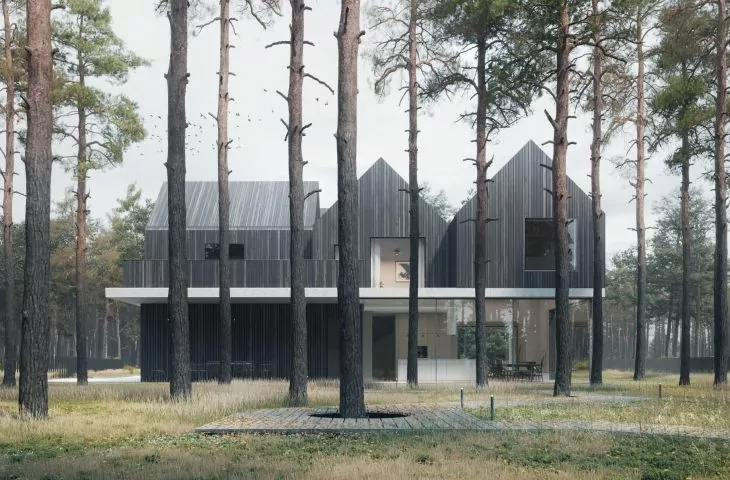On a plot of land near Warsaw, surrounded on three sides by forest, architects from the 89 Degrees studio designed a modern single-family house, which, as the designers emphasize, with its shape subtly refers to the style of wooden summer architecture popular in the area at the turn of the 19th and 20th centuries - Świdermajer.
At first glance, it is difficult to see in the design inspiration from the wooden buildings with pointed tops, full of openwork ornaments, elements so characteristic of the Swidermayer style. However, a certain lightness can be seen in it, mainly due to the huge glazing on the first floor, simplicity of form and, most importantly, matching with what's around - the centuries-old pine trees surrounding the house.
The 


The house visually and functionally is divided into two parts
image: Piotr Banak © 89 Degrees
The lump of the suburban house is visually and functionally divided into two parts - the lower, somewhat simpler, though full of cutouts, arcades and canopies, and the upper, which is formed by four unevenly stacked mini-houses with gabled roofs. The house is approached by a path zigzagging between the trees, running all the way to a large terrace, which can be accessed from the spacious living area with kitchen, living room and dining room. This zone opens with large glazings to two sides. The first floor, in turn, is separated into a more private night area - bedrooms, bathrooms and terraces are located there.
first floor plan
© 89 degrees
Architects from the Warsaw studio 89° talk about the project, functional and structural solutions.
Ola Kloc: What was most important for the investors?
89 Degrees: Already the first visit to the plot gave a clear indication of what to pay special attention to - the centuries-old trees and the forest atmosphere of the plot. The functional layout of the house, all openings and directions were subordinated to the view of the surroundings and an attempt to blur the boundary between inside and outside. Creating harmony between nature and architecture was a priority for both us and the investors.
Ola: From the outside, the house looks as if it is made up of two blocks - a modern, simple, full of glazing lower part and, referring to the archetype of a house with a gabled roof, a disjointed upper floor. The whole is united by a consistent facade material. What influenced such a shape of the object? How did you functionally solve both parts?
89 Degrees: The designed house has about 250m2 of floor space. The idea of a disjointed block came from the need to lose the scale of a large building and to make a very subtle reference to the aforementioned archetype of a house with a gabled roof. In addition, the solid mimics the distribution of functions in the building. The expansive first floor is the open living area of the building, a common space for the whole family. On the first floor is located the night zone with rooms for parents and children. Each room on the first floor is a private "cottage".
axonometries
© 89 degrees
Ola: In the visualizations, the interior of the living area looks impressive - the glazed first floor invites the forest inside, and an exposed wooden roof truss towers above the room. How do you structurally plan to solve this part of the house to achieve an equally light effect?
89 Degrees: Our idea was to leave the first floor glazing without additional structural elements. The load-bearing elements are reinforced concrete discs for the height of two floors that form the walls of the living room. The first floor glazing itself is also wider than the actual width of the living room - so from the outside we have the impression that half of the first floor is a glazed cubicle. The fact that we only have an exposed truss above the living room, rather than a full story, lends lightness, but also makes it easier to solve the structure here.
spacious living area
vision: Piotr Banak © 89 Degrees
Ola: Thank you for the interview.






































